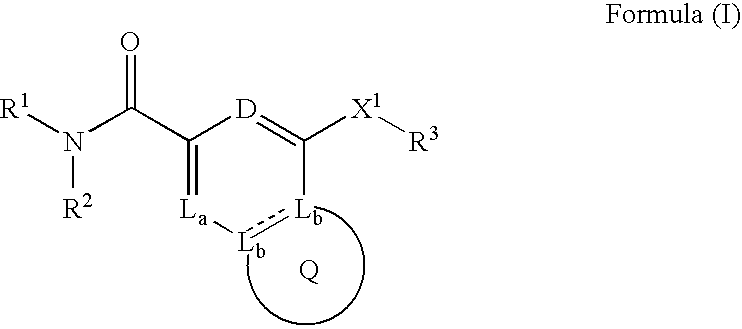Heterobicyclic metalloprotease inhibitors
a metalloprotease inhibitor and heterocyclic technology, applied in the direction of biocide, cardiovascular disorder, drug composition, etc., can solve the problem of developing effective mmp inhibitors
- Summary
- Abstract
- Description
- Claims
- Application Information
AI Technical Summary
Benefits of technology
Problems solved by technology
Method used
Image
Examples
example 1
Preparative Example 1
[0550]
Step A
[0551]A mixture of commercially available 5-bromo-indan-1-one (1.76 g), hydroxylamine hydrochloride (636 mg) and sodium acetate (751 mg) in methanol (40 mL) was allowed to stir for 16 h at room temperature. Water (100 mL) was added and the resulting precipitate was filtered and washed with water (3×20 mL) to afford the title compound (1.88 g; >99%) as a colourless solid. [MH]+=226 / 228.
Step B
[0552]To a solution of the title compound from Step A above (1.88 g) in diethyl ether (20 mL) at −78° C. under an atmosphere of argon was slowly added a 1M solution of lithium aluminum hydride in diethyl ether (42.4 mL). The mixture was heated to reflux (40° C.) and allowed to stir for 5 h. The mixture was cooled to 0° C. and water (1.6 mL), 15% aqueous sodium hydroxide (1.6 mL) and water (4.8 mL) were carefully and sequentially added. The resulting mixture was filtered through Celite® and the filtrate was concentrated to give the title compound (1.65 g; 94%) as a...
example 2
Preparative Example 2
[0557]
Step A
[0558](5-Cyano-indan-1(S)-yl)-carbamic acid tert-butyl ester (1.0 g) was suspended in 6N hydrochloric acid (50 mL) and heated to 110-112° C. for 20 h upon which the solution became homogeneous. The solvent was removed under reduce pressure to give the intermediate. [M=Cl]+=178.
Step B
[0559]The intermediate from Step A above was dissolved in anhydrous MeOH (150 mL) and saturated with anhydrous hydrogen chloride gas. The reaction mixture was then heated to reflux for 20 h. After cooling to room temperature, the solvent was removed under reduced pressure to give an oil. The oil was taken up in dichloromethane and washed with saturated NaHCO3. The organic phase was separated and dried over MgSO4, filtered and concentrated to give 1(S)-amino-indan-5-carboxylic acid methyl ester (0.66 g, 89% over two steps) as an oil which slowly crystallized into a light brown solid.
example 3
Preparative Example 3
[0560]
Step A
[0561]3-Bromo-2-methyl-benzoic acid (20.0 g) was dissolved in anhydrous THF (200 mL) under nitrogen and the reaction vessel was cooled to 0° C. in an ice bath. To this cooled solution was added BH3-THF complex (1M in THF, 140 mL) dropwise over a 3 h period. Once gas evolution had subsided, the reaction mixture was warmed to room temperature and stirred for an additional 12 h. The mixture was then poured into 1N hydrochloric acid (500 mL) cooled with ice and then extracted with Et2O (3×150 mL). The organic extracts were combined, dried over anhydrous MgSO4, filtered, and then concentrated to afford the intermediate (18.1 g; 97%) as a colourless solid. 1H-NMR (CDCl3) δ=2.40 (s, 3H), 4.70 (s, 2H), 7.10 (t, 1H), 7.30 (d, 1H), 7.50 (d, 1H).
Step B
[0562]The intermediate from Step A above (18.1 g) was dissolved in anhydrous CH2Cl2 (150 mL) under nitrogen and the reaction vessel was cooled to 0° C. in an ice bath. To this cooled solution was added PBr3 (5.52 ...
PUM
| Property | Measurement | Unit |
|---|---|---|
| Fraction | aaaaa | aaaaa |
| Fraction | aaaaa | aaaaa |
| Fraction | aaaaa | aaaaa |
Abstract
Description
Claims
Application Information
 Login to View More
Login to View More - R&D
- Intellectual Property
- Life Sciences
- Materials
- Tech Scout
- Unparalleled Data Quality
- Higher Quality Content
- 60% Fewer Hallucinations
Browse by: Latest US Patents, China's latest patents, Technical Efficacy Thesaurus, Application Domain, Technology Topic, Popular Technical Reports.
© 2025 PatSnap. All rights reserved.Legal|Privacy policy|Modern Slavery Act Transparency Statement|Sitemap|About US| Contact US: help@patsnap.com



